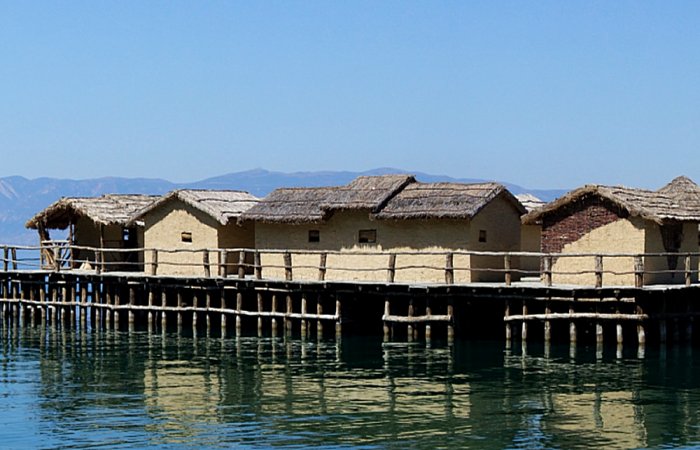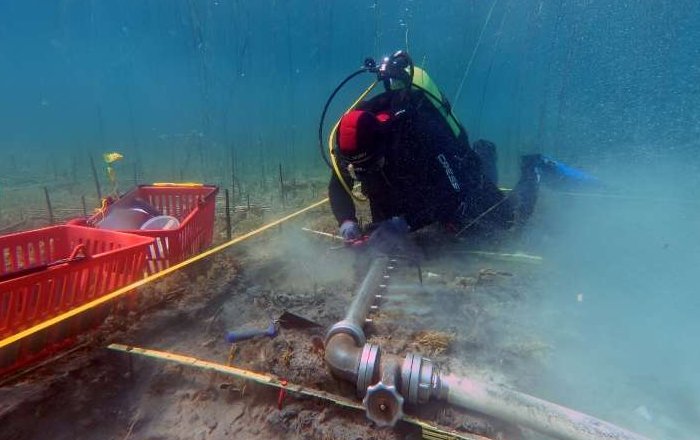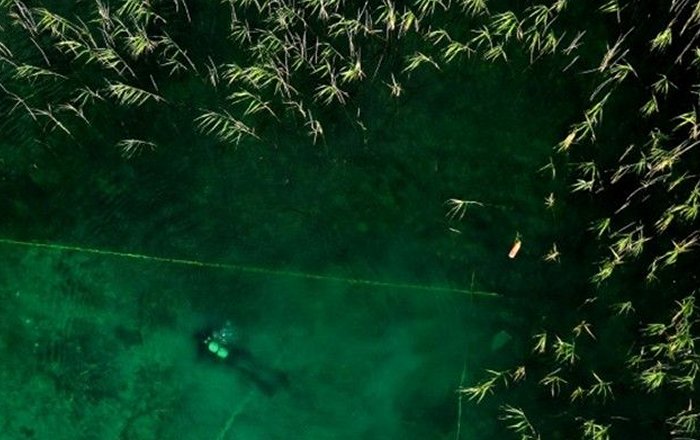Conny Waters – AncientPages.com – Researchers have uncovered what may be Europe’s oldest settlement now located beneath the waters of Lake Ohrid, (the “Pearl of the Balkans.”). The Lake Ohrid in the mountains of Albania and North Macedonia is the oldest lake in Europe.

(Example). Reconstruction of Bronze Age stilt houses on Lake Ohrid, near Peštani, North Macedonia. Image credit: – CC BY-SA 3.0
This ancient settlement is a lakeside village with stilt houses inhabited by people about 8.000 years ago.
Interestingly, the village was found guarded by defensive spikes, and it is a mystery for researchers to solve. During the recent underwater excavations, the team found the defensive structures that contained thousands of spikes, driven into the lake’s bottom, forming barricades. However, for now, it is only a speculation, and further investigations have to be conducted to find the exact reason for the need for such a mᴀssive fortification.
As Albert Hafner, an expert in European Neolithic lake dwellings, said, to protect themselves in such a way, the residents “had to cut down a forest.”
This ancient site is between 6000 and 5800 BC, but as Prof. Hafner said:
“These are radiocarbon dates. They’re inaccurate. We want to use dendrochronology, i.e. with the help of the annual rings of trees, to determine the age to the decade or even to the year.”
“It is several hundred years older than previously known lake-dwelling sites in the Mediterranean and Alpine regions,” said Hafner, a professor of archaeology from Switzerland’s University of Bern.

A diver scouring an archaeological site at the bottom of Lake Ohrid in Albania, the site of Europe’s oldest stilt village. Image via AFP
“To our knowledge, it is the oldest in Europe,” he told AFP.
The ancient settlement is located on the Albanian side of Lake Ohrid, positioned around the tripoint of Albania, North Macedonia, and Greece. It has long been known that Central Europe, Neolithic, and Bronze Age lakeside settlements are found in this region, including so-called pile dwellings. These ancient sites on or in the lakes of the southwestern Balkans are largely unexplored.
The areas have been regularly flooded by rising waters, and because of this, such dwellings were located on stilts.
Previously, it was believed that ancient villages in the Italian Alps dating back to 5000 BC were thought to be the oldest European settlements, Hafner informed.
The Lake Ohrid region has a rich archaeological history, the lake itself has been around for more than a million years, reports AFP.
The underwater excavation is yielding valuable insights into the daily life of its ancient inhabitants. Resources of the underwater archaeology contributed much and archaeologists, ᴀssisted by professional divers, found fossilized fragments of wood, including prized pieces of oak.
As Prof. Hafner said: “Oak is like a Swiss watch, very precise, like a calendar.”

A diver scouring an archaeological site at the bottom of Lake Ohrid in Albania, the site of Europe’s oldest stilt village. AFP / Adnan Beci
According to Albanian archaeologist Adrian Anastasi, an analysis of tree rings shed light on climatic and environmental conditions during that period. The site’s lush vegetation makes excavation a slow and meticulous process, and in order to “understand the structure of this prehistoric site without damaging it” researchers are “moving very slowly and very carefully.”
The ancient village relied on agriculture and domesticated livestock for sustenance. According to Ilir Gjepali, an Albanian archaeology professor working at the site, the arachaeologists found seeds, plants, and bones of both wild and domesticated animals. Archaeologists anticipate that it will take another two decades to fully explore and study the site.
The aim of the research at Lake Ohrid is ultimately to find out when and how agriculture and animal husbandry originated in the region. And how they got to Switzerland from southern Europe.
(With inputs from AFP and other sources)
Written by Conny Waters – AncientPages.com Staff Writer





